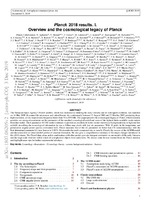| dc.contributor.author | Aghanim, Nabila | |
| dc.contributor.author | Akrami, Yashar | |
| dc.contributor.author | Arroja, Frederico | |
| dc.date.accessioned | 2020-11-06T12:41:48Z | |
| dc.date.available | 2020-11-06T12:41:48Z | |
| dc.date.issued | 2020 | |
| dc.identifier.citation | Aghanim, N.et al . (2020) . Planck 2018 results: I. Overview and the cosmological legacy of Planck.Astronomy and Astrophysics ,641,A1. Doi: https://doi.org/10.1051/0004-6361/201833880 | en_US |
| dc.identifier.issn | 1432-0746 | |
| dc.identifier.uri | http://hdl.handle.net/10566/5389 | |
| dc.description.abstract | The European Space Agency’s Planck satellite, which was dedicated to studying the early Universe and its subsequent evolution, was launched on 14 May 2009. It scanned the microwave and submillimetre sky continuously between 12 August 2009 and 23 October 2013, producing deep, high-resolution, all-sky maps in nine frequency bands from 30 to 857 GHz. This paper presents the cosmological legacy of Planck, which currently provides our strongest constraints on the parameters of the standard cosmological model and some of the tightest limits available on deviations from that model. | en_US |
| dc.language.iso | en | en_US |
| dc.publisher | EDP Sciences | en_US |
| dc.subject | Cosmology: observations | en_US |
| dc.subject | Cosmology: theory | en_US |
| dc.subject | Cosmic background radiation | en_US |
| dc.subject | Surveys | en_US |
| dc.title | Planck 2018 results: I. Overview and the cosmological legacy of Planck | en_US |
| dc.type | Article | en_US |

